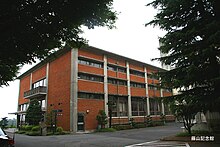Aiichirō Fujiyama
Aiichirō Fujiyama | |
|---|---|
藤山 愛一郎 | |
 | |
| Director of the Economic Planning Agency | |
| In office 3 June 1965 – 4 November 1966 | |
| Prime Minister | Eisaku Satō |
| Preceded by | Mamoru Takahashi |
| Succeeded by | Eisaku Satō (acting) |
| In office 18 July 1961 – 6 July 1962 | |
| Prime Minister | Hayato Ikeda |
| Preceded by | Hisatsune Sakomizu |
| Succeeded by | Hayato Ikeda (acting) |
| Minister of Foreign Affairs | |
| In office July 10, 1957 – July 19, 1960 | |
| Prime Minister | Nobusuke Kishi |
| Preceded by | Nobusuke Kishi |
| Succeeded by | Zentaro Kosaka |
| Chairman of Japan Airlines | |
| In office August 1951 – September 1953 | |
| Preceded by | Position established |
| Succeeded by | Kunizō Hara |
| Personal details | |
| Born | May 22, 1897 Tokyo, Japan |
| Died | February 22, 1985 (aged 87) Tokyo, Japan |
| Political party | Liberal Democratic Party |
| Alma mater | Keio University (Incomplete) |
Aiichirō Fujiyama (藤山 愛一郎, Fujiyama Aiichirō, May 22, 1897 – February 22, 1985) was a Japanese politician of the Liberal Democratic Party and business executive.[1]


A business executive who symbolized "big business" in Japan as president of Dai Nippon Sugar Manufacturing Co. and executive officer of Nitto Chemical Industry Co., he used his influence to bring about the fall of Prime Minister Hideki Tōjō in 1944.
After Japan's World War II surrender, Fujiyama was imprisoned without a trial for three years, having been accused of "war crimes". After his release he represented Japan at the 1951 UNESCO meeting in Paris and later served as Chairman of Japan Airlines (1951-1953).
In 1955 and 1956, Fujiyama, who was Chairman of the Japan Chamber of Commerce at the time, strongly supported Nobusuke Kishi as a successor to Ichirō Hatoyama to the President of the Liberal Democratic Party, according to a report by the Central Intelligence Agency.[2]
Fujiyama was elected to Parliament in 1957 and was reelected five times. As Foreign Minister in the cabinet of Prime Minister Nobusuke Kishi (1957–60), he headed Japan's first delegation to the United Nations (1957), helped revise the U.S.–Japan Security Treaty (1960), and promoted the restoration of diplomatic relations between Japan and China. He also served in the cabinet of Kishi's successor Hayato Ikeda as Director of Japan's Economic Planning Agency.[3]
During the 1960s, he controlled a personal faction within the LDP, closely aligned with the Kishi faction, and ran unsuccessfully several times for presidency of the LDP.
In 1970, Fujiyama made an unsanctioned trip to the People's Republic of China in an effort to expand Japanese trade relations with China.
External links
[edit]References
[edit]- ^ "Aiichiro Fujiyama, 87; Ex-Japanese Politician". The New York Times. 1985-02-23. ISSN 0362-4331. Retrieved 2023-05-27.
- ^ "INFORMATION REPORT, KAYA OKINORI VOL.11". Central Intelligence Agency.
- ^ Kapur, Nick (2018). Japan at the Crossroads: Conflict and Compromise after Anpo. Cambridge, Massachusetts: Harvard University Press. p. 94. ISBN 978-0674984424.


 French
French Deutsch
Deutsch